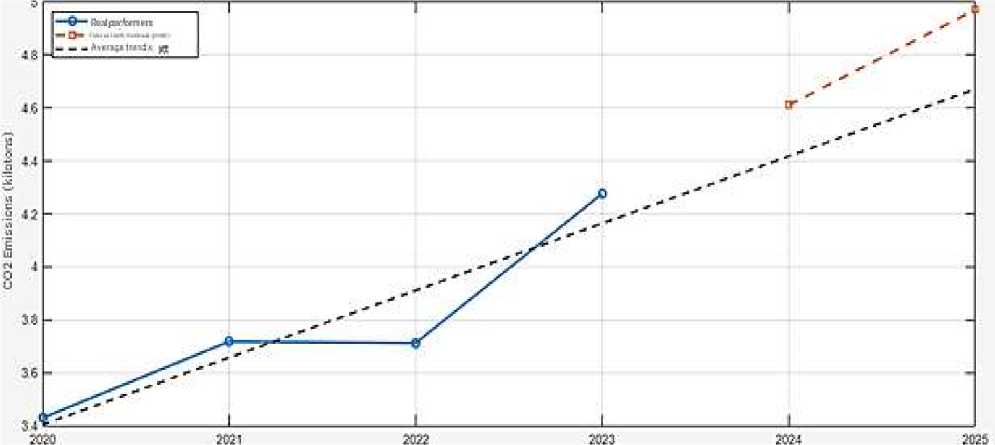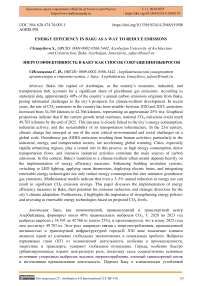Energy Efficiency in Baku as a way to Reduce Emissions
Автор: Ismayilova S.
Журнал: Бюллетень науки и практики @bulletennauki
Рубрика: Естественные науки
Статья в выпуске: 10 т.11, 2025 года.
Бесплатный доступ
Baku, the capital of Azerbaijan, as the country’s economic, industrial, and transportation hub, accounts for a significant share of greenhouse gas emissions. According to statistical data, approximately 40% of the country’s annual carbon emissions originate from Baku, posing substantial challenges to the city’s prospects for climate-resilient development. In recent years, the rate of CO₂ emissions in the country has been notable: between 2020 and 2023, emissions increased from 34,305 kilotons to 42,766 kilotons, representing an approximate 25% rise. Graphical projections indicate that if the current growth trend continues, national CO₂ emissions could reach 49,703 kilotons by the end of 2025. This increase is closely linked to the city’s energy consumption, industrial activity, and the sustainability of its transportation infrastructure. In the 21st century, climate change has emerged as one of the most critical environmental and social challenges on a global scale. Greenhouse gas (GHG) emissions resulting from human activities, particularly in the industrial, energy, and transportation sectors, are accelerating global warming. Cities, especially rapidly urbanizing regions, play a central role in this process, as high energy consumption, dense transportation flows, and intensive industrial activities constitute the main sources of carbon emissions. In this context, Baku’s transition to a climate-resilient urban model depends heavily on the implementation of energy efficiency measures. Enhancing building insulation systems, switching to LED lighting, applying smart thermostats, deploying electric buses, and integrating renewable energy technologies not only reduce energy consumption but also minimize greenhouse gas emissions. Mathematical models indicate that even a 3–5% annual reduction in energy use can result in significant CO₂ emission savings. This paper discusses the implementation of energy efficiency measures in Baku, their potential for emission reduction, and strategic directions for the city’s climate adaptation. Furthermore, it highlights the importance of strengthening energy policies and investing in renewable energy technologies based on projected CO₂ levels.
Baku, energy efficiency, carbon emissions, sustainable city, renewable energy, urbanization
Короткий адрес: https://sciup.org/14133925
IDR: 14133925 | УДК: 504; 628.474.76.003.1 | DOI: 10.33619/2414-2948/119/08
Текст научной статьи Energy Efficiency in Baku as a way to Reduce Emissions
Бюллетень науки и практики / Bulletin of Science and Practice
UDC 504; 628.474.76.003.1
Material and methodology of the research
Climate-Resilient Urban Concept and Baku – A climate-resilient city is one that implements sustainable strategies in energy, transportation, water, and land use to adapt to changing climatic conditions and minimize greenhouse gas emissions . Although some steps toward this concept have been initiated in Baku, the process remains at an early stage. Rapid urbanization, the expansion of the vehicle fleet, and the presence of outdated energy infrastructure contribute to increasing emissions [1]. Energy efficiency refers to the ability to achieve the same outcome with reduced energy consumption, made possible through technology and management. Reducing energy use simultaneously lowers CO2 and other greenhouse gas emissions. A simple formula for calculating emissions:
E = C xf where: E — carbon emissions (kg CO2); C — energy consumption (kWh); f — emission factor (kg CO2/kWh).
In this formula, energy consumption (measured in kWh) is multiplied by the emission factor of the chosen fuel or energy source. Emission factors vary depending on the type of energy, e.g., natural gas, coal, or electricity have different carbon footprints. This approach provides a straightforward and practical estimation of the carbon dioxide released into the atmosphere relative to energy usage. Increasing energy efficiency and transitioning to cleaner energy sources directly reduce emissions.
Average greenhouse gas emissions in Azerbaijan (2015–2020) were approximately 33,000 kilotons of CO2 [2-4].
Baku accounts for roughly 40% of this total, or 13,000-14,000 kilotons of CO2. Key sources of emissions in the city include: Transportation: increase in private vehicles and inefficient public transport; Buildings: old, uninsulated constructions and energy-inefficient heating systems; Industry: particularly the energy and construction sectors.
Energy efficiency initiatives and potential impacts. Buildings: In urban areas, the largest share of energy consumption is associated with heating, cooling, and lighting systems. Therefore, improving insulation systems is critical. High-quality thermal insulation reduces heat loss in winter and minimizes additional energy use for cooling in summer. Replacing traditional lighting with LED systems enables significant electricity savings. The implementation of smart thermostats allows users to monitor and control energy consumption in real time. Systematic application of these measures, validated through energy audits, enhances building energy efficiency.
Transportation reforms: In large cities like Baku, a significant portion of carbon emissions comes from the transport sector. One of the main reform strategies is expanding the use of electric buses, which reduce both air pollution and fuel costs. Additionally, creating bicycle lanes and prioritizing pedestrians promotes a healthier, more sustainable urban lifestyle. Intelligent transportation management systems optimize traffic flows, reducing fuel consumption and, consequently, emissions [1, 5].
Renewable energy and technologies: Modern urban development strategies emphasize the importance of integrating renewable energy sources. The installation of solar panels in both residential and public buildings can provide environmentally sustainable electricity generation. Moreover, smart city projects enable effective energy management, efficient resource use, and realtime energy balance monitoring. These technologies not only improve energy efficiency but also strengthen cities’ capacity to adapt to climate change.
Emission Reduction Using a Mathematical Model
Cn = C0x (1 — r)n where: Cn – energy consumption after the nnn-th year (kWh), C0 – initial energy consumption (kWh), r – annual reduction rate, n – number of years.
Table
CARBON EMISSION INDICATORS OF AZERBAIJAN, 2020–2023
|
Year |
CO2 Emissions in Azerbaijan (Fossil CO2 from Fuel Combustion and Extraction, kilotons) |
|
2020 |
-34,305 |
|
2021 |
^ 37,187 |
|
2022 |
^ 37,130 |
|
2023 |
^ 42,766 |
In 2020, emissions showed a slight decrease (≈ 34,305 kt), which can be attributed to the impact of the COVID-19 pandemic, restrictions on economic activity, and reduced energy consumption in certain sectors [2].
In 2021–2022, emissions remained relatively stable or exhibited a slight increase — approximately 37,187,090 tons in 2021 and 37,129,640 tons in 2022. In 2023, however, a significant rise was observed, reaching ~ 42.766 million tons CO2-eq. This increase may be associated with economic recovery, as well as the growth of energy production and consumption.
Figure illustrates the changes in Azerbaijan’s carbon emission levels for the period 2020– 2025. The blue line of the graph represents actual statistical data for 2020–2023, showing a generally upward trend in CO2 emissions. From 2020 to 2021, emissions increased by approximately 8.4%; in 2022 a slight decline was recorded, but in 2023 a sharp rise of about 15.15% occurred. This growth can be linked to the intensification of economic activity in the industrial and energy sectors [4].
The orange line of the graph presents projected CO2 emission levels for 2024 and 2025, based on the average growth rate calculated for 2020–2023. According to these projections, if the current trend continues, emission levels may reach 49,703 kilotons by 2025.
In addition, a trend line — constructed using linear regression for the period 2020–2023 — is included in the graph, providing a simplified representation of the overall growth trajectory.

Figure. Changes in Azerbaijan’s carbon emissions, 2020–2025.
Conclusion
Energy efficiency and the use of renewable energy sources play a crucial role in Baku’s efforts to combat climate change. Enhancing insulation systems in buildings, transitioning to LED lighting, implementing smart thermostats, and introducing electric buses in the transport sector can significantly reduce both energy consumption and CO2 emissions. Statistical data indicate that CO2 emissions in Azerbaijan increased rapidly between 2020 and 2023, with projections suggesting they may reach 49,703 kilotons by 2025.
Mathematical models demonstrate that even a 3–5% annual reduction in energy use can lead to a substantial decrease in emissions. Therefore, the systematic implementation of short- and medium-term energy efficiency measures will not only reduce the city’s carbon footprint but also enhance ecological sustainability and improve residents’ quality of life. Consequently, Baku’s transition to a climate-resilient urban model will provide both economic and environmental benefits.


